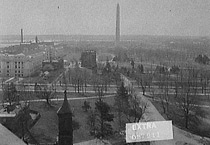
THE NATIONAL MALL: An Illustrated History
IV. The Mall as Public Forum in the Twentieth Century
The McMillan Plan slowly took shape on the Mall during the twentieth century.
 |
 |
| FIGURE 8: View of tree-covered Mall from Smithsonian Castle, c. 1915 (Photo: Library of Congress) |
FIGURE 9: WWI and WWII temporary buildings flanking Lincoln Memorial and Reflecting Pool, c. 1942 (Photo: Library of Congress) |
The nineteenth century trees were finally removed from the area between the Capitol and the Washington Monument in the 1930s. Temporary buildings erected during World War I and World War II to the north and south of the Reflecting Pool, and at the base of the Washington Monument, were finally taken down in the 1970s.
|
|
| FIGURE 10: View of the Mall from the Capitol to the Lincoln Memorial, c. 1980 (Photo: Tom Wachs) |
|
|
| FIGURE 11: Rev. Dr. Martin Luther King, Jr.'s "I Have A Dream" speech in 1963 |
The Mall became our nation’s premier public forum in the twentieth century, a full expression of the L’Enfant concept of the Mall as the people’s place. It has grown in meaning as the people have made new history on its sacred ground. The Lincoln Memorial is now associated also with civil rights, dating back to Marian Anderson's concert in 1939, and including the March on Washington in 1963 and Martin Luther King, Jr.'s "I Have A Dream" speech.
The monuments to American founding principles, and the open public spaces stretching between them, have provided the stage for innumerable public celebrations, civic gatherings, and demonstrations.
|
|
| FIGURE 12: Public celebrations and demonstrations in the 1980s and 90s. (Photo: Tom Wachs) |
Next: The Mall Today and the Need for Protection
|